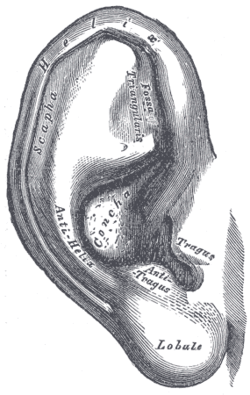Helicis major
| Helicis major | |
|---|---|
 The muscles of the ear (Helicis major visible at center right). | |
| Details | |
| Origin | Spina helicis |
| Insertion | Anterior border of the helix |
| Artery | Auricular branches of posterior auricular and auricular branch of occipital arteries |
| Nerve | Facial nerve |
| Identifiers | |
| Latin | Musculus helicis major |
| TA | A15.3.01.037 |
| FMA | 48968 |
The helicis major (or large muscle of helix[1]) is an intrinsic muscle of the outer ear.
In human anatomy, it is the form of a narrow vertical band situated upon the anterior margin of the helix, at the point where the helix becomes transverse.[1]
It arises below, from the spina helicis, and is inserted into the anterior border of the helix, just where it is about to curve backward.[2]
The function of the muscle is to adjust the shape of the ear by depressing the anterior margin of the ear cartilage. While the muscle modifies the auricular shape only minimally in the majority of individuals, this action could increase the opening into the external acoustic meatus in some.[2]
The helicis major is developmentally derived from the second pharyngeal arch.[2] It seem that only in primates is the helicis minor and major two distinctive muscles.[3]
Additional images
|
See also
References
This article incorporates text in the public domain from the 20th edition of Gray's Anatomy (1918)
- 1 2 "Definition: 'Helicis Major (muscle)'". MediLexicon International Ltd. Retrieved 9 March 2013.
- 1 2 3 "Helicis major". AnatomyExpert. Retrieved 9 March 2013.
- ↑ Diogo, Rui; Wood, Bernard. Comparative Anatomy and Phylogeny of Primate Muscles and Human Evolution. Taylor & Francis Inc. p. 371. ISBN 978-1-57808-767-9.
